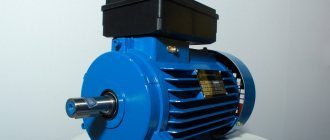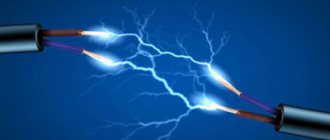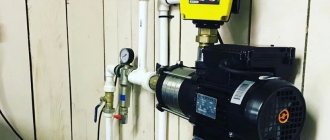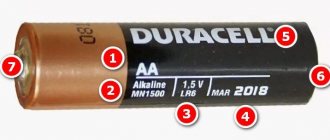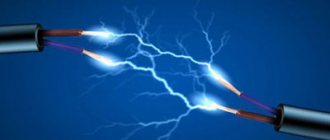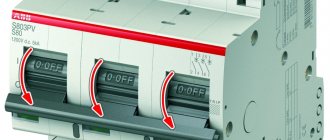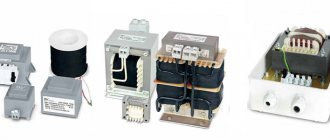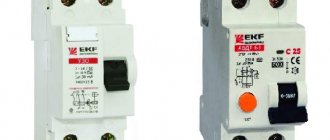To power household devices and industrial equipment, a source of electricity is required. It is possible to generate electric current in several ways. But the most promising and cost-effective today is the generation of current by electric machines. The easiest to manufacture, cheapest and most reliable in operation turned out to be an asynchronous generator, which generates the lion's share of the electricity we consume.
The use of electric machines of this type is dictated by their advantages. Asynchronous electric generators, unlike synchronous generators, provide:
- higher degree of reliability;
- long service life;
- efficiency;
- minimal maintenance costs.
These and other properties of asynchronous generators are inherent in their design.
Design and principle of operation
The main working parts of an asynchronous generator are the rotor (moving part) and the stator (fixed part). In Figure 1, the rotor is located on the right and the stator on the left. Pay attention to the rotor design. There are no copper wire windings visible on it. In fact, windings exist, but they consist of aluminum rods short-circuited to rings located on both sides. In the photo, the rods are visible in the form of oblique lines.
The design of short-circuited windings forms a so-called “squirrel cage”. The space inside this cage is filled with steel plates. To be precise, aluminum rods are pressed into slots made in the rotor core.
Rice. 1. Rotor and stator of an asynchronous generator
An asynchronous machine, the structure of which is described above, is called a squirrel-cage generator. Anyone who is familiar with the design of an asynchronous electric motor has probably noticed the similarity in the structure of these two machines. In essence, they are no different, since the asynchronous generator and the squirrel-cage electric motor are almost identical, with the exception of additional excitation capacitors used in generator mode.
The rotor is located on a shaft, which sits on bearings clamped on both sides by covers. The entire structure is protected by a metal casing. Generators of medium and high power require cooling, so a fan is additionally installed on the shaft, and the housing itself is made ribbed (see Fig. 2).
Rice. 2. Asynchronous generator assembly
Operating principle
By definition, a generator is a device that converts mechanical energy into electrical current. It does not matter what energy is used to rotate the rotor: wind, potential energy of water, or internal energy converted by a turbine or internal combustion engine into mechanical energy.
As a result of rotor rotation, magnetic field lines formed by the residual magnetization of the steel plates cross the stator windings. An EMF is generated in the coils, which, when active loads are connected, leads to the formation of current in their circuits.
In this case, it is important that the synchronous speed of rotation of the shaft is slightly (about 2 - 10%) higher than the synchronous frequency of alternating current (set by the number of stator poles). In other words, it is necessary to ensure asynchrony (mismatch) of the rotation speed by the amount of rotor slip.
It should be noted that the current obtained in this way will be small. To increase the output power it is necessary to increase the magnetic induction. They achieve an increase in the efficiency of the device by connecting capacitors to the terminals of the stator coils.
Figure 3 shows a diagram of a capacitor-excited asynchronous welding alternator (left side of the diagram). Please note that the field capacitors are connected in a delta configuration. The right side of the figure is the actual diagram of the inverter welding machine itself.
Rice. 3. Scheme of a welding asynchronous generator
There are other, more complex excitation schemes, for example, using inductors and a bank of capacitors. An example of such a circuit is shown in Figure 4.
Figure 4. Device diagram with inductors
Difference from synchronous generator
The main difference between a synchronous alternator and an asynchronous generator is the rotor design. In a synchronous machine, the rotor consists of wire windings. To create magnetic induction, an autonomous power source is used (often an additional low-power DC generator located on the same axis as the rotor).
The advantage of a synchronous generator is that it generates a higher quality current and is easily synchronized with other alternators of a similar type. However, synchronous alternators are more sensitive to overloads and short circuits. They are more expensive than their asynchronous counterparts and more demanding to maintain - it is necessary to monitor the condition of the brushes.
The harmonic coefficient or clearing factor of asynchronous generators is lower than that of synchronous alternators. That is, they generate almost pure electricity. The following operate more stable at such currents:
- UPS;
- adjustable chargers;
- modern television receivers.
Asynchronous generators provide reliable starting of electric motors that require high starting currents. In this indicator, they are actually not inferior to synchronous machines. They have fewer reactive loads, which has a positive effect on thermal conditions, since less energy is spent on reactive power. An asynchronous alternator has better output frequency stability at different rotor speeds.
Kinds
There are several classifications of asynchronous generators. They may differ due to the following factors.
- The type of rotor is the rotating part of the structure. Today manufactured units of this type include a phase or squirrel-cage rotor in their design. The first is equipped with an inductive winding, which is an insulated wire. With its help, it is possible to create a dynamic magnetic field. The second option is a single structure with a cylindrical shape. Inside it there are pins equipped with two closing rings.
- Number of working phases. They mean output or stator windings located inside the device. The output can have one phase or three. This indicator determines the purpose of the generator. The first option is available for operation at a voltage of 220 V, the second - 380 V.
- Connection diagram . There are several ways to organize the operation of a three-phase generator. You can connect the coils to the device using a star or delta circuit. They can also be placed on the poles of a stationary element - the stator.
Additionally, asynchronous type generators are classified by the presence or absence of a self-excitation coil winding.
Classification
Short-circuit type generators are most widespread due to the simplicity of their design. However, there are other types of asynchronous machines: alternators with a wound rotor and devices using permanent magnets that form an excitation circuit.
Figure 5 shows two types of generators for comparison: on the left, based on an asynchronous motor with a squirrel-cage rotor, and on the right, an asynchronous machine based on an IM with a wound rotor. Even a quick glance at the schematic images reveals the complex design of the wound rotor. The presence of slip rings (4) and a brush holder mechanism (5) attracts attention. The number 3 indicates the grooves for the wire winding, to which current must be supplied to excite it.
Rice. 5. Types of asynchronous generators
The presence of field windings in the rotor of an asynchronous generator improves the quality of the generated electric current, however, such advantages as simplicity and reliability are lost. Therefore, such devices are used as a source of autonomous power only in those areas where it is difficult to do without them. Permanent magnets in rotors are used mainly for the production of low-power generators.
So which type of alternator is best?
It depends on how exactly you will use the equipment.
- To connect computer and household appliances, as well as for laboratories, medical institutions, and offices, a brush generator is needed, preferably with an AVR.
- For construction sites, workshops and other places where dust, moisture, dirt can get into the engine, as well as for welding work, a brushless generator is one hundred percent suitable.
As already mentioned, synchronous generator sets are still more popular even despite their high cost. After all, if the electronic equipment connected to them deteriorates, it will cost much more. At the same time, engineers continue to work on improving both types of alternators. Thus, for asynchronous ones, the output voltage becomes more and more stable, while synchronous ones gradually improve the level of protection.
Application area
The most common use of generator sets with a squirrel cage rotor. They are inexpensive and require virtually no maintenance. Devices equipped with starting capacitors have decent efficiency indicators.
Asynchronous alternators are often used as an autonomous or backup power source. Portable gasoline generators work with them, they are used for powerful mobile and stationary diesel generators.
Alternators with three-phase windings reliably start a three-phase electric motor, therefore they are often used in industrial power plants. They can also power equipment in single-phase networks. The two-phase mode allows you to save fuel on the internal combustion engine, since the unused windings are in idle mode.
The scope of application is quite extensive:
- transport industry;
- Agriculture;
- household sphere;
- medical institutions;
Asynchronous alternators are convenient for the construction of local wind and hydraulic power plants.
RESULTS
RESULTS ´Ð¾Ð² индÑкÑионнÑÑ Ð¿ÑибоÑов, но ÑÑÑÑойÑÑво гРµÐ½ÐµÑаÑоÑа Ñозд ROOM CONTENT:
- RESULTS otp.
- бмоÑка Ñ Ð¸Ð½Ð´ÑÑиÑÑÑÑейÑÑ Ð¿ÐµÑеменной ÐÐС.
RESULTS º, º RESULTS, RESULTS RESULTS.
RESULTS, CONDITIONS ROOM regurgitation Ñгого. ROOM ´ÐµÐ¹ÑвÑÐµÑ Ñвоей обмоÑкой и кÑÑÑиÑÑÑ Ð²Ð¾ÐºÑÑ Ð³ гоÑизонÑалÑного л RESULTS. RESEARCH. RESULTS µÑÑÑ ÑкоÑем (ÑÑÑаÑоÑом).
DIY asynchronous generator
Let’s make a reservation right away: we are not talking about making a generator from scratch, but about converting an asynchronous motor into an alternator. Some craftsmen use a ready-made stator from a motor and experiment with the rotor. The idea is to use neodymium magnets to make the rotor poles. A workpiece with glued magnets might look something like this (see Fig. 6):
Rice. 6. Blank with glued magnets
You glue magnets onto a specially machined workpiece mounted on the electric motor shaft, observing their polarity and shift angle. This will require at least 128 magnets.
The finished structure must be adjusted to the stator and at the same time ensure a minimum gap between the teeth and the magnetic poles of the manufactured rotor. Since the magnets are flat, you will have to grind or sharpen them, while constantly cooling the structure, since neodymium loses its magnetic properties at high temperatures. If you do everything correctly, the generator will work.
The problem is that it is very difficult to make an ideal rotor in artisanal conditions. But if you have a lathe and are willing to spend a few weeks making adjustments and modifications, you can experiment.
I propose a more practical option - turning an asynchronous motor into a generator (see video below). To do this, you will need an electric motor with suitable power and an acceptable rotor speed. The engine power must be at least 50% higher than the required alternator power. If you have such an electric motor at your disposal, start processing. Otherwise, it is better to buy a ready-made generator.
For recycling you will need 3 capacitors of the KBG-MN, MBGO, MBGT brands (you can take other brands, but not electrolytic ones). Select capacitors for a voltage of at least 600 V (for a three-phase motor). The reactive power of the generator Q is related to the capacitor capacity by the following dependence: Q = 0.314·U2·C·10-6.
As the load increases, the reactive power increases, which means that in order to maintain a stable voltage U it is necessary to increase the capacitance of the capacitors, adding new capacitances through switching.
Video: making an asynchronous generator from a single-phase motor - Part 1 https://www.youtube.com/watch?v=ZQO5S9F72CQ
Part 2 https://www.youtube.com/watch?v=nDCdADUZghs
Part 3 https://www.youtube.com/watch?v=6M_w1b2xyM8
Part 4 https://www.youtube.com/watch?v=CONHg7p-IYE
Part 5 https://www.youtube.com/watch?v=z2YSqVh1vM8
Part 6 https://www.youtube.com/watch?v=FNU83kOeSbA
To simplify the selection of capacitors, use the table:
Table 1
| Alternator power (kW-A) | Capacitor capacity (uF) at idle | Capacitor capacity (uF) at average load | Capacitor capacity (µF) at full load |
| 2 | 28 | 36 | 60 |
| 3,5 | 45 | 56 | 100 |
| 5 | 60 | 75 | 138 |
In practice, the average value is usually chosen, assuming that the load will not be maximum.
Having selected the parameters of the capacitors, connect them to the terminals of the stator windings as shown in the diagram (Fig. 7). The generator is ready.
Rice. 7. Capacitor connection diagram
How to choose?
When purchasing, first of all, focus on the conditions in which the generator will operate.
First, determine the required power. It must exceed the total power of simultaneously switched on consumers. It is recommended to have a small (or large) supply in case of emergency.
Select fuel type. Decide what is more important to you - efficiency or the ability to start in any conditions.
If congestion is possible in the network, you need to buy a synchronous model. But keep in mind that it will require more careful maintenance than asynchronous and has a shorter service life. Yes, and you will have to spend money on a security system. If overloads are completely excluded, an asynchronous generator would be the best choice.
Then check the workmanship.
- Turn the rotor by hand. It should rotate easily. Crunching, clicking and jerking in the bearings is not allowed, as is the beating of the rotor. It should not wobble in the bearings.
- Contacts and terminals should be shiny. Broken threads are not allowed. If there are wires, their reliable insulation is required. Especially at joints and bends.
- There should be no cracks on the stator and frame. Carefully inspect the support part.
- Check generator operation. The readings of the measuring equipment must be stable. The exhaust sound must be smooth.
- Responsible manufacturers carefully paint the product and attach the logo well. If the paint is in doubt, it is better to refuse such a generator.
- The credibility of any company is determined by the quality of service. Make sure that if a problem occurs, you can find a professional to fix it.
Then look for additional features
- It would be good if measuring instruments were already installed at the factory.
- It is better to buy models that have both a manual start and a starter.
- Check the ease of transportation. If there are wheels, they should spin well. If there are handles, they should be comfortable to hold.
And don’t be afraid to ask questions to consultants, even, in their opinion, ridiculous ones. The time you spend choosing is more than compensated for by trouble-free operation.
Tips for use
An asynchronous generator does not require special care. Its maintenance consists of monitoring the condition of the bearings. At nominal modes, the device can operate for years without operator intervention.
The weak link is the capacitors. They can fail, especially when their denominations are incorrectly selected.
The generator heats up during operation. If you often connect increased loads, monitor the temperature of the device or take care of additional cooling.
Voltage regulator
The basic principle of operation of the voltage regulator is based on maintaining the energy of the on-board network in all operating modes with various changes in the rotation frequency of the generator rotor, ambient temperature and electrical load. This device can also perform secondary functions, namely, protect parts of the generator set from possible emergency operation of the installation and overload, automatically connect the excitation winding circuit to the on-board system or alarm the emergency operation of the device.
All such devices work on the same principle. The voltage in the generator is determined by several factors - current strength, rotor speed and magnetic flux. The lower the load on the generator and the higher the rotation speed, the higher the voltage of the device will be. Due to the greater current in the excitation winding, the magnetic flux begins to increase, and with it the voltage in the generator, and after the current decreases, the voltage also becomes less.
Regardless of the manufacturer of such generators, they all normalize the voltage by changing the excitation current in the same way. As the voltage increases or decreases, the excitation current begins to increase or decrease and conduct the voltage within the required limits.
In everyday life, the use of generators greatly helps a person in solving many emerging issues.
Features of the scheme
The generator circuit of an asynchronous motor is quite simple. It does not require special skills. When you start the development without connecting to the power supply, rotation will begin. Having reached the appropriate frequency, the stator winding will begin to generate current.
If you install a separate battery of several capacitors, the result of such manipulation will be a leading capacitive current.
The parameters of the generated energy are influenced by the technical characteristics of the generator and the capacitance of the capacitors used.
